St Albans Cathedral, Hertfordshire Exterior (Interior here) |
||||
|
Notes in italics from Hertfordshire by Nikolaus Pevsner and
Bridget Cherry (1977) Yale University Press, New Haven and London. |
||||
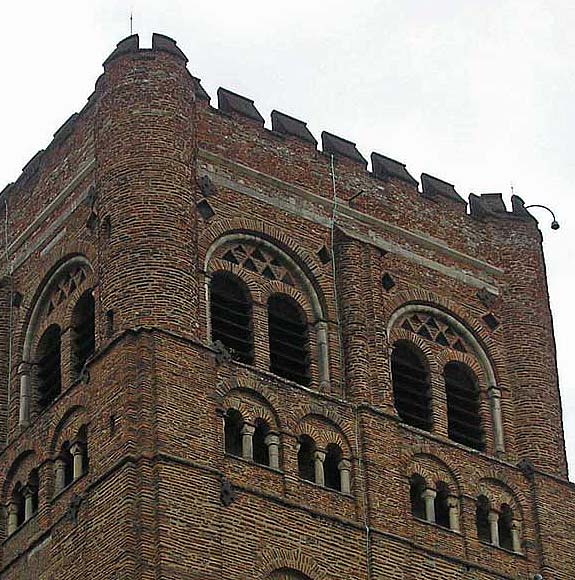 |
||||
| St Alban died in 209, one of the earliest Christian martyrs in Latin Europe. The shrine on the site of his execution was replaced by a monastic church already by the end of the C4. Of this building and its Anglo-Saxon successors no remains are left ... The picture above is of the Norman tower of the late 1100s, using Roman bricks from the earlier Roman town of Verulamium close by where Alban lived. | ||||
| Click on photos below to enlarge | ||||
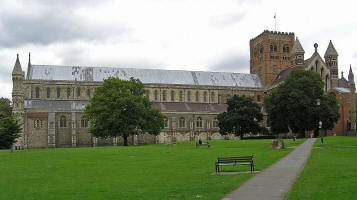 |
||||
| The first impression of the present
cathedral is one of unbalanced length: a nave nearly 300 ft long, and no
attempt to match it with high towers. ... Two W towers were planned in
the late C12, and in the later Middle Ages the crossing tower would have
had a spire... In
approaching the building and getting a closer view of its Norman parts,
the most striking peculiarity is the russet and blackish-grey colouring
of the Roman brick and flint, which was originally, of course, all
plastered white. ... |
||||
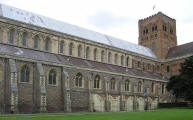
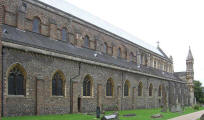
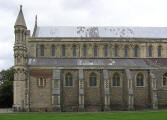 |
||||
| The Norman church was built at one go
... by Paul of Caen, the fourteenth abbot, between 1077 and 1088. .... A
hundred years after ... Abbott John of Cella (1195-1214) lengthened the nave by rebuilding the W
bay and adding three further bays
(best seen in clerestory in second and third picture) ... The style he used was E.E.
(Early English), and St Albans is amongst the earliest
representatives of the style. ... The W parts were completed only c.1230
under William of Trumpington ... So in 1230 the nave at St Albans had
nine Norman bays and four E.E., ... In 1323 five piers on the S side of
the Norman nave collapsed causing much further damage, and so, in a
style blending with the E.E. W bays ... the S side of the Norman nave was rebuilt
(see clerestory in first picture). ... The aisle windows were all altered by Lord Grimthorpe (late 19th century). The developments described above are seen on the outside in the top clerestory. The first picture shows the south side of the nave, with the earliest, i.e. Norman, part at the tower end, the first Early English part at the west end (on left), the second Early English part (following collapse of Norman section) in the middle. The second picture shows the north side where the middle section is still Norman; that side of the nave did not collapse. The last picture shows detail at the west end of the nave, with the Early English extension seen in the clerestory (On the outside it is handsomely shafted, with a larger arch for each lancet window and smaller, more pointed, blank arches between). The later Early English section in the middle on the south side was less ornate. |
||||
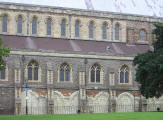
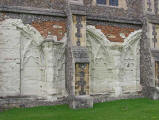
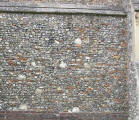 |
||||
| Of the monastic buildings little can
now be seen. ... Blank arcading and the springers of the vault of the
CLOISTER. This went along the the E half of the S side of the nave. The
remains are clearly of the early C14. The blank arcading (broken into by
Lord Grimthorpe's buttresses) had three lights in each arch, each light
containing a pointed trefoil above a triple cusp. ... Last picture: flint interspersed with Roman bricks. |
||||
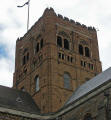 |
||||
| Norman Tower | ||||
| The exterior of the crossing tower is entirely of brick. The builders did not trust flint for construction so high in the air. Above the first stage of windows is an outer gallery of four arches of twin openings on each side, and above this the bell stage with two large twin openings with angle-shafts, and a curious piercing of the tympana by rows of little triangles. At this level the central buttresses change from flat pilasters to paired shafts separated by an angular projection. The angles of the tower are strengthened by buttress strips which at the level of the bell stage develop into circular angle supports. The use of rounded forms and shafts at this level shows that by the time the bell stage was reached the austerity of the Early Norman work was being abandoned. The tower has later battlements (rebuilt by Lord Grimthorpe). | ||||
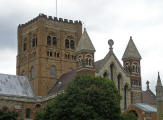
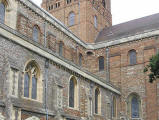
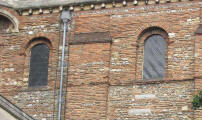 |
||||
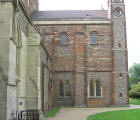

 |
||||
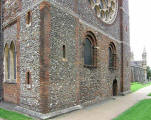
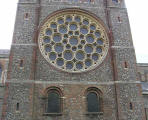
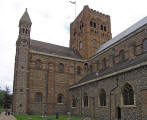 |
||||
| Norman Transepts (south in first row, north in next two rows) | ||||
| The building is of flint, with almost all the strengthening at the angles, round doors and windows, and in similar places by means of Roman bricks taken freely from old Verulamium. Only a very little stone was available. Arches and windows are completely unadorned (no more than one step back instead of any mouldings). The walls are articulated by strip-like flat buttresses without set-offs (rather than lesenes). ... In the N and W walls of the N transept the ground-floor windows survive (bottom row), and in both transepts the clerestory windows. ... In the late 19th century Lord Grimthorpe gave the S transept a spectacular group of E.E. lancets (on the S side), the N a large, rather thin rose window. ... Each transept end is now flanked by symmetrical staircase turrets. ... | ||||
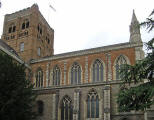
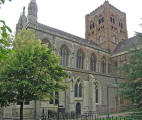

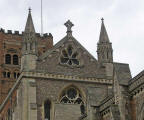 |
||||
| The next addition to the church was the replacement of the Norman E end by one more spacious and up to date. ... The major scheme for a new E end was started in 1257 (with the chancel). This involved the rebuilding of both aisles, apart from the first bays, and the covering of the solid walls between aisles and choir (which were left standing) with tall blank arcades (see interior). ... The chancel ends to the E in ... a large and excellent group of a four-light Geometrical window and two flanking lancets. The large window has two trefoils and above them a splendid large octofoil ... | ||||
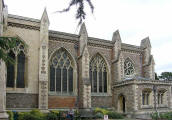
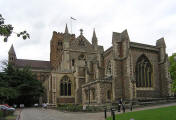 |
||||
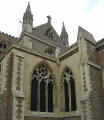

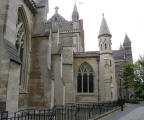 |
||||
| The E exterior (beyond the
chancel) consists of the retrochoir and the Lady Chapel. Contrary to custom the Lady Chapel was
the last undertaken ... it was completed about 1320. The retrochoir carries on the line of the chancel
aisles ... The Lady Chapel itself must be called Dec (Decorated), although it has none of the fantasies of East Anglia or Yorkshire. A special effort was made here (e.g., the outer walls of these E parts were intended to be, and were partly, stone-faced). |
||||
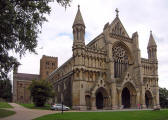

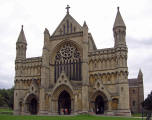 |
||||
| In the early 19th century, the west front of early 13th century was in great decay and in need of restoration. St Albans is the only one of the major churches of England which has a W front completely, or almost completely, Victorian. It is the work of Lord Grimthorpe, designed in 1879 and built at his own expense. ... Of the upper parts of the facade nothing is C13: a nine-light Perp window was demolished by Lord G. to replace it by his Late Geometrical one. | ||||
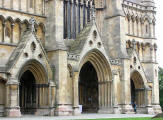

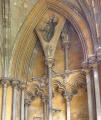
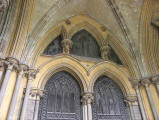 |
||||
| The porches are are original in their structure, but only in a few details. ... | ||||
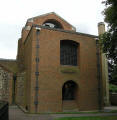
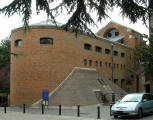 |
||||
| The CHAPTER HOUSE adjoining the south side. The original chapter house was destroyed in the 15th century after the Dissolution. This new chapter house was designed by William Whitfield and opened in 1982. Red bricks made by hand to be compatible with the Norman church. | ||||
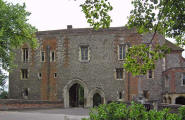
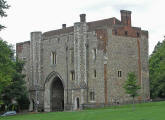
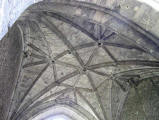 |
||||
| The GATEHOUSE which survives in all its bulk. It stands in a line with the S aisle of the church, c.50 ft away from it, with the gateway leading from N to S into the the abbey precincts. The building is due to Abbot de la Mare, and dates from the 1360s. It is of flint with stone dressings, a big, broad, fortress-like structure. The gateway is divided on the N side by a pier into a carriageway and a pedestrian entrance, but on the S side there is only one very wide and high opening, flanked by rectangular turrets. The lierne-vault has a central octagon of ribs inscribed into a four-pointed star. ... | ||||
| Interior | ||||
|
Cathedral Website About Saint Alban in Wikipedia |
||||